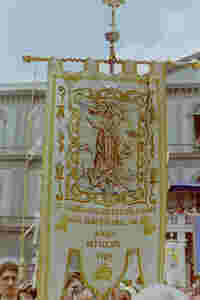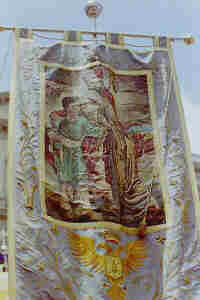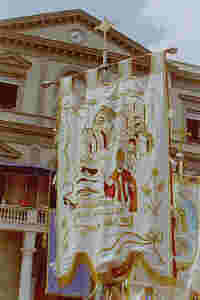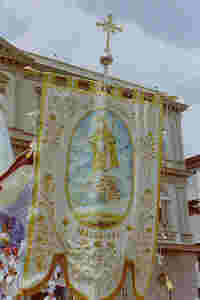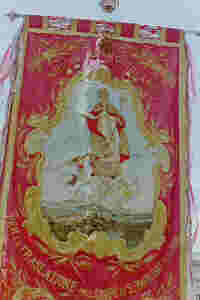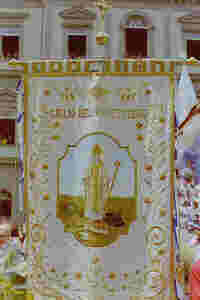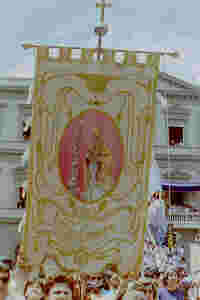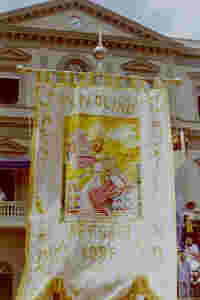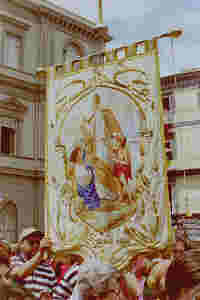Gigli of Nola
---------------------------------------------------------------------------------------------
Located about 30 km from Naples and reachable via the motorway Napoli-Bari, Nola and 'one of most' famous in the South. Its secular traditions are witnessing the CATHEDRAL, neoclassical style, the fourteenth-century church of St. Felix and St. Blaise (called the Mercy), the sixteenth-century palaces and Sheaves Orsini.Among the historical figures who somehow had relationships with Nola, remember: Giordano Bruno, who was born here, died in Rome burnt alive at Campo de 'Fiori (sixteenth century); Pomponio de' Algerio, who was also born in Nola died in Rome in a cauldron of boiling oil 'cause Lutheran (XV century), the Emperor Octavian Augustus wished to die here, in the house that was' of his ancestors. (14 ac).But the character who is remembered with more solemnity 'and' definitely S.Paolino (Ponzo Meropio Paolino 353-431 AD) who was Bishop of Nola. He and A 'for the feast of the Lilies, and to him and' credited with the invention of bells (or such Nolae Campanae).The Feast of the Lilies originated on June 26 of an unspecified year of the fifth century. On that day St. Paulinus returned from Africa after having redeemed with his person the last hostage, the son of a widow, who was still in the hands of bandits. The others I had redeemed by giving all his possessions.He was greeted on the beach Oplonti (now Torre Annunziata) by the people of Nola in the head with the banners of trade guilds. In his hands the people brought flowers (lilies) collected in the countryside.Perhaps it already 'is repeated the following year' the event to commemorate the heroic gesture of the Holy.Over the years and centuries the lilies were first brought on woods, then click cataletti wooden towers so high that by the seventeenth century the Bishop and 'forced to give their blessing to the streets' cause too high to bring in the Cathedral . This brings us to today, with wooden towers as high as 30 meters covered with papier mache, which develop historical, religious or topical '.The number of lilies and 'eight, in memory of the number of delegates who welcomed St. Paulinus, and they are: Ortolano, Salumiere, publican, Baker, boat (with over S.Paolino and' or 'Turkish' to accompany 'the Holy One in home), butcher, cobbler, blacksmith, Tailor.
The Festival of Gigli
The party for the next year begins on the Sunday following June 22. It is awarded on this day the Lily of the new "Master of the Day" and that 'the representative of one of eight corporations. He will take charge 'of the construction of Giglio (entrusted to local families who handed down the secrets of building father to son) and choose the "Cape Paranza" and that' the character that drives the "Paranza" which carries the lily. The "Paranza 'and' a group of over 200 people that rotation of 150 to raise the lily shoulder. They are arranged in parallel rows on all 4 sides. The effort and 'remarkable, but is overcome by the will' and dedication.The procedure for the preparation of Giglio requires several steps that take place during the year:'At Expulsion: procession with brass band parading through the streets with the new master of the party.
'A deposit: amount of money that is given to the musicians who will play on the lily, manufacturers, representatives of the trawler by the Master of the Feast.
The Exchange: Delivery of the flag from the old to the new Master of the Feast.
'A Tavuliata: establishment of the committee which will provide' the costs of construction of Giglio.
'A Song: presentation of the musical motif that accompany' the Gigli.
Aizata d'' to beads:important moment of wooden construction, with the beginning of June. Involves the construction of the First Borda, and that 'the pole that forms the backbone of Giglio (25 meters). We proceed with the construction of the base consisting of 20x20 cm by 4 feet high and 3 meters wide 2.60 meters. So the 6 pieces of the prospectus to 3.90mt, 3.70mt, 3.50mt, 3.30mt, 3.10mt, 3m. Is reached so 'height of about 25m and a weight of about 30 tons.'O juorno ca' if they try 'and shoulders: the Lily is taken from the construction of the Master of the house party. This will also try the "fishing boats".'A dress nova and' the task that requires the application of decorative paper mache.'O holy pe' way: procession with the silver bust of the saint.'A magical evening: E' on the Saturday preceding the day of the "Ballad of the lilies." The committees promoters parade through the streets with the official uniform.
You then come to:
'O juorno cchiu' bello
We came to Sunday. The day begins at 9 am with the celebration of Holy Mass near the lilies. Then the men of paranza take place under the base by inserting the bars of various lengths (up to 6m) with a thickness of 12cm. From the house of "Master of the party" are brought in Piazza del Duomo. Here the Bishop, in procession with the bust of the saint and the banners of the eight confederations, blesses the Lilies, and after a short speech, part of the Cathedral.After a brief lunch stop will be the way to the ballad of lily.From the cathedral square of the lily 'ORTOLANO, followed in order by butcher, publican, BAKER, BOAT, butcher, SHOEMAKER, SMITH, TAILOR, begins his tour through the streets of the city'.The path followed and 'the same for centuries and includes several tests that highlight the qualities' of the trawler headed skill' head trawler. Along the way you make several stops for rest and allow the return of the trawler men. We make several rounds to 360 °, becomes "Paranza (displacement of the lily) left and right, you leap gilgio once or twice, and important test, the cry" Cuoncio Cuoncio and jetta "of capoparanza, leaving dropped the lily trying to vibrate the tip of that as little as possible.From these practices, the judges on the tracks, evaluate and vote. Fatigue and stress are huge. But the men of Mediterranean fish are able to sing even while carrying the lily. We then making several stops along Via San Felice, while the musicians sing the song of the lily and other Neapolitan songs. At the crossroads with Via Senator Cocozza, (top view) meets the first difficulty. ' To cross the intersection should be removed because men and sidebars 'point and' very closely.Continue along Via A.Leone with songs and dances of the people before the lily. This leads into one of the most 'difficult whole pathway: the turn of Prisons.Here we see the real trick 'of capoparanza to the real strength of the trawler. You begin to see the first signs of fatigue with the appearance of bumps due to rubbing of the bars on the neck. You must rotate the lily a 180 ° turn in a narrow space without hitting the bars against the wall and 'was, for the occasion, painted white to highlight any "touch"..A step that is performed without impact the exultation of men of Mediterranean fish.Proceed to Via and Via Meriliani Tansillo. Here you will stop until the arrival of all the lilies in the queue.It retraces Via S. Felice in the opposite direction to the above, so for Via S. Paolino you reach Piazza MGMarcello.A brief stop and restart it for the last test: Vico Piciocchi.The men were exhausted, but we must overcome this alley without stopping, without side bars and men, and everything else 'was unnecessary.Many lilies are tilted during the race, someone bumps into even the cornices of the adjacent buildings, but do not stop for no reason!Once past this hurdle, we report the lily in the Piazza del Duomo, or it is left in Via T.Vitale.At the last step lily, that of Taylor, about eight o'clock the next day.But the party continues the next day:'A rubbed: men and women of fish, lilies left stisciano via T.Vitale to Piazza del Duomo.'O blow' and core: after a few days spent at the square, the lilies of the coatings are stripped and disassembled.But there 's time for regrets, they are already' been assigned the lilies of the new year to the masters of celebration: people are prepared to celebrations .......
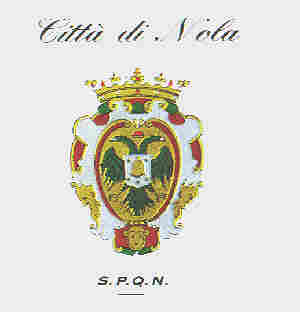
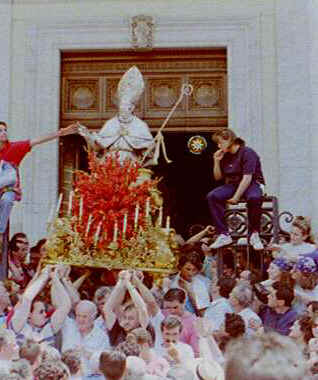
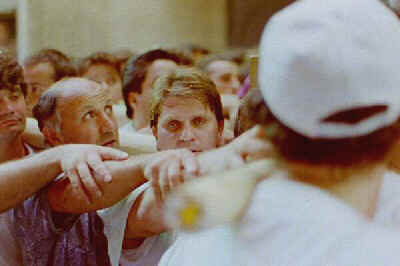
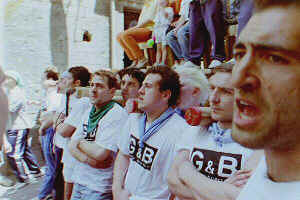
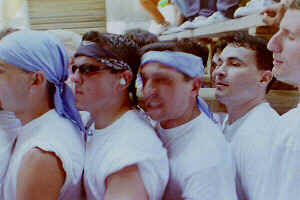
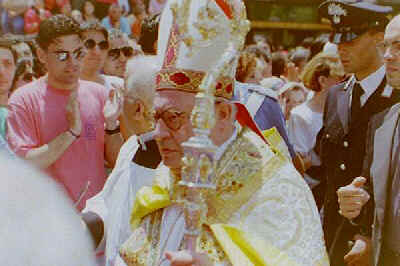
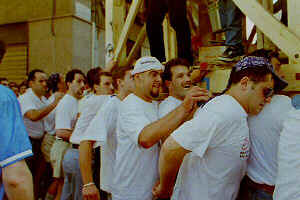
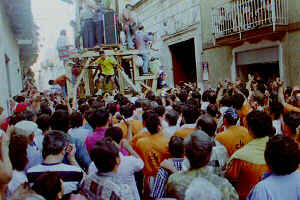
GONFALONI
